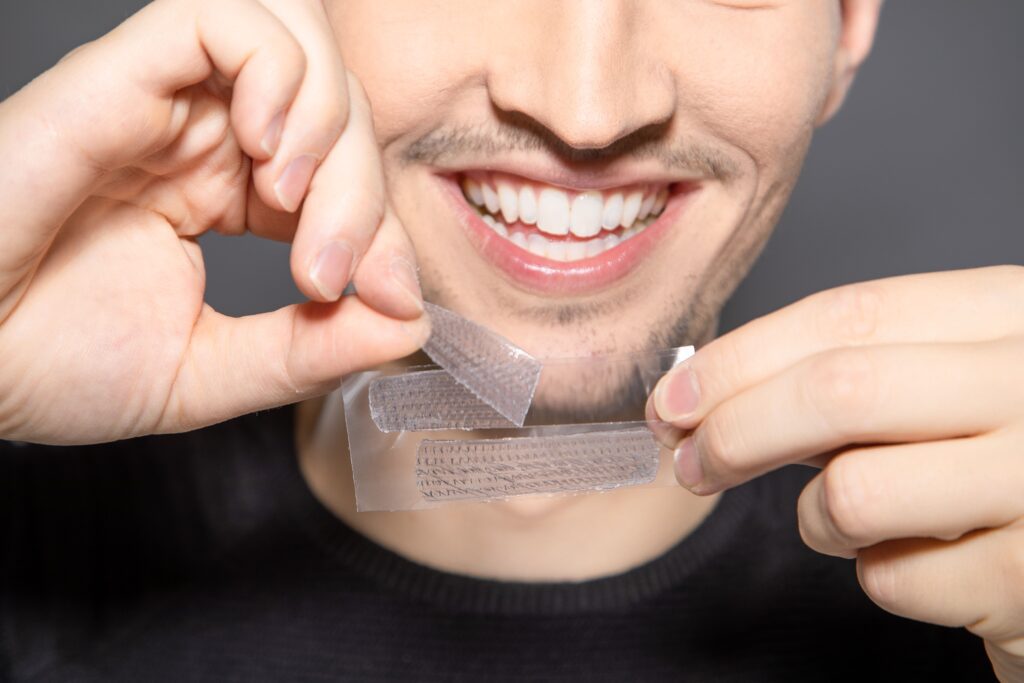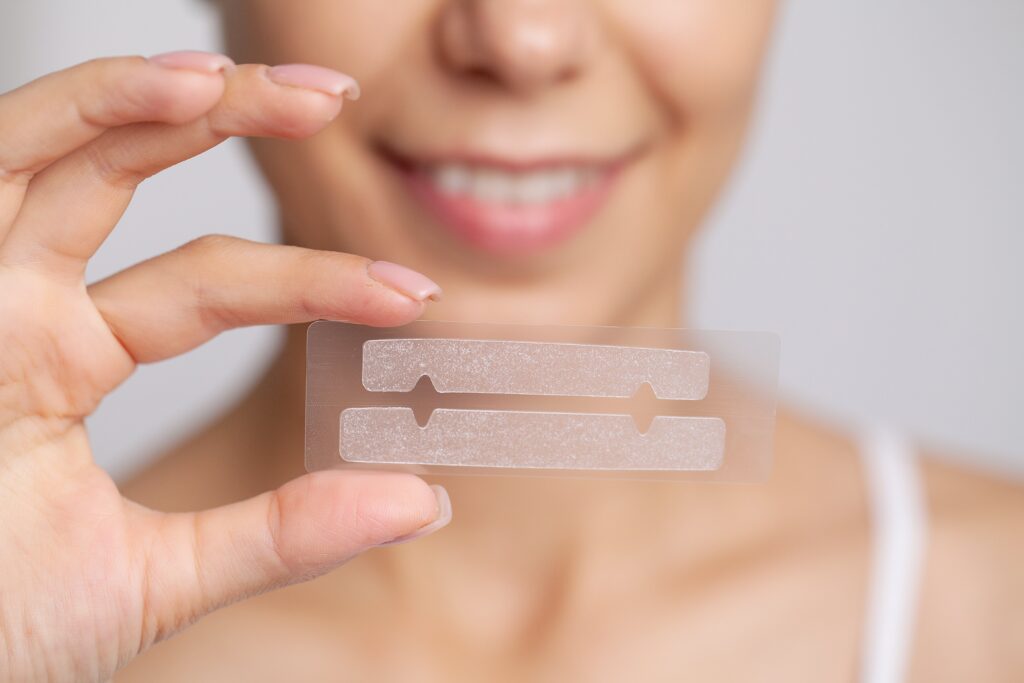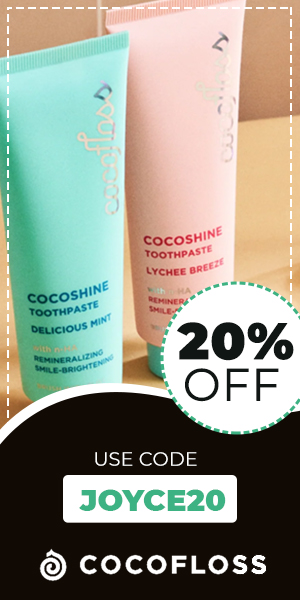Joyce the Dentist Highlights:
- Noticeable whitening for 3–6 months after a full strip cycle
- Safe to repeat 2–4 cycles per year with proper 3-month recovery intervals
- Easy daily habits to extend results and minimize sensitivity
- Immediate post-treatment care to rehydrate enamel and prevent stains
- Quarterly touch-ups (1 week) for consistent brightness
At-home whitening strips brighten your smile for 3–6 months after a single 10–14-day course. With simple touch-ups, you can safely repeat 2–4 cycles a year without worrying about sensitivity.
They’re a go-to for busy schedules because they’re convenient, cost-effective, and super easy: just peel, stick, and smile!
How Long Do Whitening Strips Last?
What’s the Typical Duration?
After a 10–14-day whitening strip course, most people see a noticeably brighter smile for about 3–6 months.
Your habits matter. Sipping coffee, tea, or red wine can speed up fading. Brushing and flossing regularly helps your results last longer.
Stick to good oral care, and you might enjoy that glow for closer to six months. If you indulge in staining foods or skip your nightly floss, you could notice it wearing off sooner.
What Affects How Long Results Last?
Product Strength. Strips with higher peroxide content work faster, but they can also bump up sensitivity.
Oral Hygiene. Brushing twice a day and flossing daily keeps plaque (and new stains) from settling in.
Diet & Lifestyle. Love your morning coffee, afternoon tea, or an evening glass of red wine? Those (and tobacco) speed up restaining.
Maintenance Frequency. A quick 1-week touch-up every 2–3 months is all it takes to keep fading at bay.
Why Do Teeth Stain in the First Place?
Teeth stain when colored compounds (called chromogens) cling to the enamel’s microscopic pores. Over time, these pigments build up and dull your smile.
- Extrinsic stains sit on the surface. Things like coffee, tea, wine, berries, and tobacco leave behind pigments that latch onto enamel.
- Intrinsic stains form deeper inside the tooth. Aging, certain medications (like tetracycline), trauma, and genetics can darken dentin over time.
- Enamel wear makes staining worse. As enamel thins with age or acid erosion, the yellower dentin shows through more easily.
Understanding these stain sources helps you tailor both prevention and whitening strategies.
What Are the Best Practices for Prolonging Whitening Strip Results?

Immediate Post-Treatment Care
Right after your strip session, your enamel is a bit dehydrated and more prone to stains. Aim to rinse or gently brush within 30 minutes of eating or sipping anything colored, as this helps wash away fresh pigments before they settle.
Keep a water bottle handy and sip often. Staying hydrated lets saliva do its natural work, rehydrating enamel and reducing that post-whitening dryness.
Recommended reading: Best Types of Water for Your Dental Health
Daily Habits
Floss every day. Plaque can cling to your teeth and trap new stains, while proper flossing helps keep that buildup at bay.
Try whitening toothpaste once or twice a week. It gives your enamel a gentle polish to maintain that bright finish.
Short-Term Avoidance
For the first 48 hours after your treatment, steer clear of deeply colored foods and drinks. Think:
- Berries
- Tomato sauce
- Tea
- Coffee
- Red wine
This short break allows your enamel time to fully rehydrate and lock in that fresh, bright finish.
Ongoing Touch-Ups
About three months after your full course, run a quick 7-day maintenance cycle. These mini touch-ups keep fading from creeping in and help you enjoy a consistently bright smile.
What Are the Side Effects & Precautions of Whitening Strips?
How Do Whitening Strips Affect Tooth Sensitivity?
Most users experience mild, temporary sensitivity to hot and cold after treatment. This happens because peroxide can momentarily open microscopic channels in enamel.
- Sensitivity usually starts within a few hours of use and subsides in 1–3 days.
- To manage, switch to a desensitizing toothpaste containing potassium nitrate. Apply it twice daily and skip whitening strips until sensitivity eases.
By understanding this common side effect, you can plan treatment around busy days and avoid discomfort.
I’ve created a comprehensive guide to my top picks for the best toothpaste for sensitive teeth.
@joycethedentist If you’ve ever experienced sensitivity with traditional teeth whitening, incorporate Sensodyne Clinical White into your pre and post-whitening routine for 2 shades whiter teeth as seen in an 8 week clinical study, and 24/7 sensitivity protection with twice daily brushing. Have you ever experienced sensitive teeth while whitening? #SensodyneClinicalWhite #Sensodyne #NoWinceWhitening #TeethWhitening #WhiteSmile #HealthySmile #ad @Sensodyne US
How Can Whitening Strips Cause Gum Irritation?
Whitening strips can irritate gums if the peroxide gel contacts soft tissue.
- To prevent it, trim strip edges and align them strictly with your teeth, not your gums.
- If you feel stinging or redness, stop using strips for a few days and let your gums recover before resuming.
By keeping the gel off your gums and following the manufacturer’s placement guide, you’ll minimize irritation and stay comfortable.
How Should You Use Whitening Strips Safely?
Always follow the manufacturer’s instructions: never wear strips longer than directed and allow at least three months of rest between full treatment courses.
- Stick to the clock. Over-wearing strips won’t speed up whitening and can harm enamel or gums.
- Space it out. Skipping consecutive courses gives teeth and soft tissue time to recover, reducing sensitivity and irritation.
How Often Can You Use Whitening Strips Per Year?
Most people stick to 2–4 full whitening strip cycles each year to keep their smile bright without overdoing it. Giving your teeth and gums at least 3 months between courses helps them recover fully and lowers the risk of sensitivity or irritation.
- 2–4 full treatments per year
- At least 3 months’ rest between each cycle
- Plan mini touch-ups in the off months to maintain results without a full course

FAQs About Whitening Strips
Do teeth go back to normal after whitening strips?
Results fade gradually over several months but won’t fully reverse. Keeping up with mini touch-ups helps maintain a bright smile.
Why do my teeth look gray after whitening?
Peroxide can temporarily dehydrate enamel, making teeth appear gray. Once enamel rehydrates (usually within 30–60 minutes), your natural color returns.
Should I brush after a whitening strip?
Wait at least 30 minutes after removing a strip before brushing to avoid added sensitivity.
What if I leave strips on longer than 30 minutes?
Wearing strips too long won’t speed up whitening. It can irritate gums and increase sensitivity without extra benefit.
How long after whitening strips can I eat?
Aim to wait 30–60 minutes before eating or drinking anything colored. This pause lets enamel fully rehydrate and lock in your results.
Morning or night—when is best?
Either time works. Just be sure not to consume staining foods or drinks immediately afterward to protect your newly brightened enamel.
Key Takeaways
- Enjoy a 3–6 month brightness window per cycle
- Limit to 2–4 cycles per year with ≥3 months between treatments
- Follow post-treatment care and daily oral habits to extend results
- Stick to recommended wear times to prevent sensitivity and irritation
Keeping your smile white doesn’t have to be complicated! Stick to these simple tips, space your cycles, and protect your enamel.
Have questions or want more personalized advice? Stay proactive about your oral health and follow @joycethedentist for more tips to keep your smile bright!





















